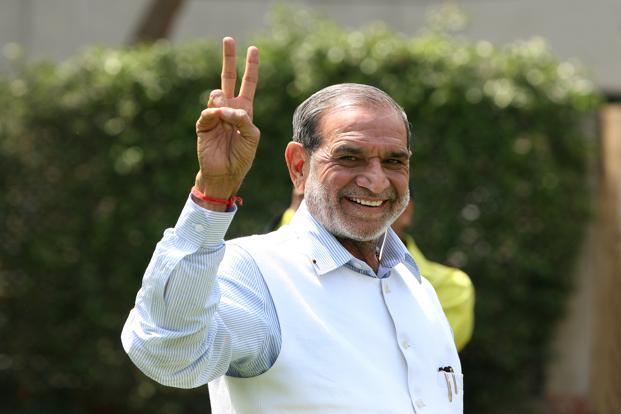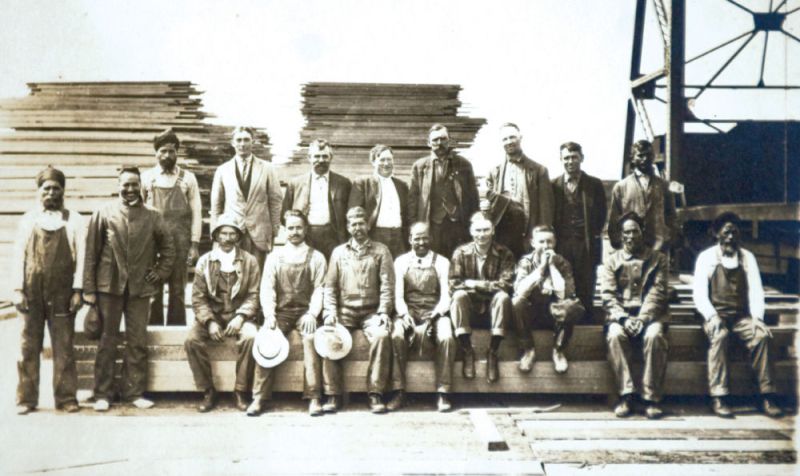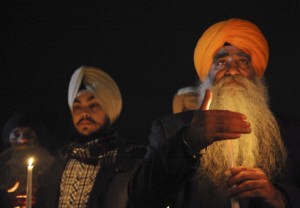
Co-blogged by American Turban and Sundari

San Quentin State Prison, California. (Image: San Quentin News.)
The Sikh Coalition, a civil rights organization, was recently asked to present to a group of inmates at San Quentin State Prison in Northern California.  Organized by the Asian Prisoner Support Committee, which has a weekly class inside San Quentin State Prison called SQ ROOTS (Restoring Our Original True Selves), the organization was asked to make a presentation about the Sikh community.  The class is modeled after Asian American Studies courses, covering topics such as history, culture, personal experiences as well as health and reentry issues.  The class is comprised of Vietnamese, Filipino, Cambodian, Hmong, Lao, Chinese, Mexican in addition to Punjabi Sikh men.
The presentation included a Sikh awareness talk followed by a discussion on the post-9/11 challenges experienced by the Sikh community, including hate crimes, school bullying, religious profiling and workplace discrimination.  It was a unique experience for both the Sikh Coalition volunteers as well as the inmates who noted at the end that they were “grateful†and “thankful†to have learned about the Sikh community and the issues that Sikh Americans were experiencing.  It was a moving experience and pushed us to think about restorative justice and the role of forgiveness within Sikhi.
Many of us on the “outside†have preconceived ideas about what life is like inside the prison system. To be sure, our few hours inside the prison and interacting with the inmates may not be a fully representative view of prison life. Yet, the warm reception we received by inmates before, during, and after our session was eye-opening; the inmates in our class were very engaged, courteous and collegial. We enjoyed the positive and warm atmosphere exuded by each member of our audience, and were touched by the obvious desire by these inmates to learn more about the Sikh community, and to even empathize with some of the issues that Sikhs in this country have faced.

In a process that took three decades, Sajjan Kumar, a leader in India’s Congress Party, was recently acquitted for his well-documented involvement in the anti-Sikh pogroms during November 1984 in which thousands of Sikhs were murdered in three days in the country’s capital city. Five co-accused were convicted. (Source: Live Mint)
About two months ago, I observed the continuing engagement by representatives of the Indian government with the Sikh American community, which in that instance took the form of an exhibition on Sikh heritage in Atlanta, Georgia, sponsored by the Government of India. This exhibit has just recently been presented in Washington, D.C., as well, and it is consistent with increased engagement and activity related to the Sikh American community — be it directly, or through lobbying of US officials — by representatives of India. The increasing effort by Indian officials to promote the Sikh community in the United States is problematic, however, as it runs contrary to India’s track record with the Sikhs in its own borders over the past several decades.
Whether in the aftermath of a hate crime (such as in Oak Creek, Wisconsin, or recently in Fresno, California), or in what appears a deliberate attempt to brand the Sikh identity with Indian nationalism, representatives of the Indian government are insisting that they be the custodians of the Sikh community in the United States.

“Indians, many of whom were Sikh, worked at the Hammond Mill before its demise in 1922. During that time period, the Indians left their mark on Astoria, participating in wrestling matches, occupying Alderbrook also known as “Hindu Alley,” and forming the Ghadar political party. Courtesy of Clatsop County Historical Society.” (source: The Daily Astorian)
One of the legacies of the earliest Sikh and Indian immigrants to the United States at the turn of the twentieth century was the creation of the Ghadar Party, a political movement based in northern California that sought to promote India’s liberation from British rule.
Led by Indian expatriates in the United States, the Ghadar Party was formed in 1913. One of its main activities was the publishing of literature to promote resistance to British rule and for a free India. Obviously a threat to the ruling class, the literature was banned in India, and upon their capture, the Ghadarites were often imprisoned or executed as terrorists by the British.
This year, the San Francisco headquarters of the Ghadar Party has been opened to the public by the Indian Consulate as a museum. The printing press that the Ghadar Party used to print their literature is also now on display at the Gurdwara in Stockton, California. However, while it was previously believed that the Ghadar Party was founded in California, historians now place the genesis of the movement further north in the state of Oregon, where Johanna Ogden recently mapped a forgotten (and primarily) Sikh settlement of laborers in 1910 known as “Hindu Alley”.

“The bodies of Shindiver Grover, 52, his wife Damanjit, 47, and their two sons, Sartag, 12 and Gurtej, 5, were found in their first-floor apartment in Johns Creek, Ga., at around 11:30 a.m. Monday, according to local reports.”
(Source: NY Daily News. Photo credit: CBS Atlanta)
Tragic news broke today that a Sikh family in Atlanta, Georgia, was found dead in their home. The bodies of father Shindiver Grover (52), mother Damanjit Grover (47) and their two sons, Sartaj (12), and Gurtej (5), were discovered in their apartment when Damanjit did not report for work on Monday.
Police are still investigating what is called a “complicated” crime scene, but believe it was a murder-suicide:
The nature of the murder – the city’s first since it was incorporated in 2006 – was troubling to even the most senior investigators, [Johns Creek police Chief Ed Densmore] said.
“We are all human. We’re all parents. We have families,” Densmore said, according to local CBS News.
“You deal with something like this, it will take a little bit out of you, of course.”
Few details have been released at this point. Prayers for the departed souls and condolences are offered to those who knew the family.
While we are still learning about the tragedy, Sikhs in the United States who are seeking resources to deal with domestic issues can contact the Sikh Family Center, who provides a confidential “culturally specific peer-counseling and non-emergency support for community members in Punjabi and English.” The Sikh Family Center message line can be reached at (408) 800-SEVA or (408) 800-7382.
For more immediate needs, the National Domestic Violence Hotline is available in 170 languages at 1−800−799−SAFE (7233). In case of emergency, always first call 911.
[Cross-posted on American Turban]
Co-blogged with Nina Chanpreet Kaur

(source: Daily Record and Sunday Mail)
“All the talking is done and now it’s time to walk the walk / Revolution’s in the air 9mm in my hand / You can run but you can’t hide from this master plan.” (Song lyrics by Wade Michael Page’s band End Apathy)
A few weeks ago, the Federal Bureau of Investigation (FBI) closed its investigation into the mass shooting that occurred at the Sikh Temple of Wisconsin in August, in which six Sikhs were murdered and wounded four others, including Lieutenant Brian Murphy of the Oak Creek Police Department, and Punjab Singh, who is still in a long-term care facility receiving treatment.
The FBI’s conclusion does not bring any closure. In the wake of Oak Creek, the specter of a growing white supremacist movement has not been adequately addressed by the media, policy makers, nor law enforcement agencies. This frames the issue of hate crimes against Sikhs as something almost incidentally perpetrated by independent murderers, and the stalling by the FBI to accurately and consistently report anti-Sikh and other hate crimes as well as link it to domestic terrorism reinforces the sense that the white supremacy movement is something federal, state and local government are not taking seriously or prioritizing. Historically, the white supremacist movement at-large has perpetrated heinous crimes fueled by hate and bias often in the guise of a member gone rogue as we saw in Oak Creek in August 2012.
Guest Blogged by Nina Chanpreet Kaur
The year 2012 has been a series of heartbreaks. There is perhaps no greater pain than surviving a child. From Oak Creek, WI to the children whose lives were innocently lost in Newtown, CT and the millions of others who die as victims of violence every day, my heart breaks. So far, our response as a nation in the wake of Friday’s tragedy has been messy and presumptuous, but also clear and action-oriented at times. Deep pain, anguish, grief and conflict tend to have that affect: forcing us into action beyond our own daily lives and bringing us a greater sense of clarity.
In the wake of Sandy Hook, conversations about mental health, gun control laws and the root of violence in our schools, homes and communities continue to flash before our eyes. In response, we each do what we know best — for some it is grappling with a new world view to make space for such loss, for others it is taking time to grieve and release anxiety, and for several more it is taking quick action. So far, the Sandy Hook tragedy has transformed the views of some politicians and community members alike — Sikh Americans included. I am hopeful that this will bring increased attention and action to the problem of gun violence that also deeply affects the Sikh community.
The Sikh American community has responded to Sandy Hook by attending and organizing vigils across the country. A young Sikh boy imparted a beautiful message to the deceased children and national community, sharing his condolences. The Kalekas, who lost their father and members of their sangat to the tragedy in Oak Creek, have organized a movement around the film Nursery Crimes and met on Monday on the steps of City Hall in New York City along with Mayor Bloomberg and other politicians demanding gun control. They plan to travel with survivors from Oak Creek, Aurora and Columbine to Newtown, CT to lend a helping hand. Both Amardeep and Pardeep Kaleka have been instrumental in shining light on the roots of violence and hate and taking quick action. Producing several videos, erecting Serve 2 Unite and building a movement around Nursery Crimes are among a few of their many tremendous efforts. We need more Sikhs who are willing to speak up about the issue of gun control and systemic violence.
Guest blogged by Nina Chanpreet Kaur
August 5th, 2012. 1:33pm. A text message from my best friend: “hostage situation at sikh temple in wisconsin. on al jazeera right now.” We pulled over and exchanged glances, holding our breath it wasn’t an attack perpetrated by someone within the Sikh community. Earlier that morning we rowed in unison, kayaking down the Hudson. Her voice coaching my every movement. Later, riding side by side, we biked to the tennis courts. The wind blowing in our faces and trailing behind our backs, sheer joy and pleasure breezed through me. We had been riding our bikes home when we pulled over. After we said our goodbyes and went our separate ways, I went to hit some tennis balls. The news hadn’t yet sunk in. Once home, my entire being collapsed. I couldn’t avoid the flood of emails, messages and calls. I kept replaying the last few hours. The extreme contrast of the deep pleasure of my morning and the tragedy of Oak Creek felt like some sort of betrayal.
As the shock lifted and the news sunk in, I laid my forehead against the naked floor of my Manhattan apartment and wept. I wept for children, little bare feet hitting cement pavement running for safety. I wept for women crammed into a closet, gunshots threatening to penetrate their bodies. I wept for the pain of separation. I wanted to be there, I wanted to hold each of the bleeding victims in my arms. I wanted to sit next to Wade Michael Page. Make him stop. Have a conversation, maybe a cup of tea. I wept for the memories of the safe gurdwara that cradled me with kirtan as a child. Such a place no longer existed.
News from Wisconsin consumed me. Guilt. Grief. Why wasn’t I there? How does the universe exist in such extremes? At sunset, I picked myself up and started to write. I wrote emails. Long emails. I asked for a vigil. I planned a vigil. I wrote poems. I published them. I lost my appetite and any desire to eat, sleep or cook. I stayed awake through the night to organize. There was no such thing as comfort or rest for me in the weeks following Oak Creek. Heartbroken, the sadness cut through my very center. Organizing was my only way out.
Co-blogged by Sundari and AmericanTurban
Last week, in the context of the significance of California’s 9th Congressional District to Sikh Americans, we sent the major candidates of California’s 9th Congressional District — incumbent Representative Jerry McNerney and challenger Ricky Gill — a questionnaire to learn more about their positions about Sikh American-related issues (see previous post here). Both candidates responded. However, the nature of the responses received were quite different.
Rep. Jerry McNerney’s campaign responded to the questionnaire and Ricky Gill’s campaign declined to answer. As we had stated in our earlier post, both responses will be printed verbatim and are below.
Co-blogged by Sundari and AmericanTurban
 Of recent and recurring discussion on The Langar Hall and American Turban has been the election race in California’s 9th Congressional District. For Sikh Americans, this district’s race is significant.Located in northern California, the 9th Congressional District contains America’s oldest and one of its largest Sikh American communities. The oldest Gurdwara in the United States (which only a couple of weeks ago celebrated its centennial anniversary) is located in this District in Stockton, California. America’s first Asian American and Sikh American member of Congress, Dalip Singh Saund, once resided in this area, and one of the candidates currently running is himself a Sikh American.Given the unique character of the District, we are interested to know the thoughts of the main candidates of the district on the issues affecting their current and potential Sikh American constituents, many of whom have been active in supporting each of the candidates. It is our plan to publish these answers by each candidate to learn more about their positions on issues affecting Sikh Americans.With election day in the US nearing, we have asked the main candidates — incumbent Representative Jerry McNerney and Republican challenger Ricky Gill — to offer their thoughts on Sikh American issues. We are aware that important concerns of the general public on issues like jobs, healthcare, or social issues are often already asked of the candidates, but that their positions on Sikh American issues are not asked of them. Accordingly, these questions reflect Sikh American concerns that do not get the same attention from mainstream media.
Of recent and recurring discussion on The Langar Hall and American Turban has been the election race in California’s 9th Congressional District. For Sikh Americans, this district’s race is significant.Located in northern California, the 9th Congressional District contains America’s oldest and one of its largest Sikh American communities. The oldest Gurdwara in the United States (which only a couple of weeks ago celebrated its centennial anniversary) is located in this District in Stockton, California. America’s first Asian American and Sikh American member of Congress, Dalip Singh Saund, once resided in this area, and one of the candidates currently running is himself a Sikh American.Given the unique character of the District, we are interested to know the thoughts of the main candidates of the district on the issues affecting their current and potential Sikh American constituents, many of whom have been active in supporting each of the candidates. It is our plan to publish these answers by each candidate to learn more about their positions on issues affecting Sikh Americans.With election day in the US nearing, we have asked the main candidates — incumbent Representative Jerry McNerney and Republican challenger Ricky Gill — to offer their thoughts on Sikh American issues. We are aware that important concerns of the general public on issues like jobs, healthcare, or social issues are often already asked of the candidates, but that their positions on Sikh American issues are not asked of them. Accordingly, these questions reflect Sikh American concerns that do not get the same attention from mainstream media.The questions that we have sent to the campaigns of Jerry McNerney and Ricky Gill are below the fold, and on Tuesday, October 30, we will publish the responses from each campaign.

Ricky Gill is the son of Sikh parents and is running to represent California’s 9th Congressional District (photo: Ricky Gill campaign website)
I have written several times in the past about Ranjit “Ricky” Gill, the Republican Party candidate for Congress in California’s 9th Congressional District. Gill is challenging Democratic Party incumbent Jerry McNerney for the seat.
Gill, 25, is the son of Sikh physicians in the Stockton, California area. Much of the donations to his campaign have come from the Sikh community, as well as interests in the healthcare and agricultural industries. The northern California constituency for which Gill is contesting is an area that has a sizable Sikh population and is, in fact, home to the first and oldest Gurdwara in the United States (the Gurdwara is celebrating its 100-year anniversary this year).
There have been a variety of questions about Gill’s candidacy, particularly based on his age and lack of experience, and claims that he is downplaying his party affiliation (indeed, the fact that he is running as a Republican is not immediately transparent on his campaign website).
In April, I wrote about the emerging perception that Ricky Gill was also distancing himself from his Sikh background:
Much like South Carolina Governor Nikki Haley did when she ran for the Governor’s seat, Gill is reportedly distancing himself from his Sikh heritage in his campaign and emphasizing a Christian background. As Haley endorsed Gill late last year, perhaps it should not be a surprise that he is following her playbook, but it is nonetheless disappointing that a Sikh American is choosing to obscure his own background for the sake of an election.
Shortly afterwards, I contacted Gill’s campaign to offer the opportunity to address this issue. I did not receive a response.
Fast forward to today, Gill’s minimal response to the attack at the Oak Creek, Wisconsin Gurdwara has reinforced the belief that Gill is dissociating himself from his religious background.

“But, when you have a beard, a mustache, it’s like a mask. You can’t see the person’s face. It’s hidden.”
As disagreeable as the words sounded, my friend’s tone was very gentle and civil. It was almost as if he was asking me the question: why bother?
I was a nine-year-old Sikh boy with a little mustache fuzz and a patka (a Sikh boy’s headcovering), speaking with the clean-shaven teenaged Hindu boy next door whom I befriended on this extended trip to India. I would often play games with his younger brother, but with this older brother, our interaction usually took the form of conversations about our different cultures and religions.
His point about hair left me somewhat at a loss. I remember his facial expression after he made his statement – curiously waiting for a response that I would not have.
Later that evening, I presented this argument to my father. “He said people can’t see our true faces because of the hair on our face.”
My father didn’t take a second to respond. “This is my face”, he said very matter-of-factly, “this is how a man’s face naturally looks.”
By now, you have likely heard of the smartphone app (available for iPhone and Android devices) released by the Sikh Coalition called FlyRights, which was released yesterday (April 30), and is free of cost. The news of this app’s release has spread virally among news outlets and has been applauded by other civil rights organizations and the general public.
FlyRights allows travelers (Sikh or otherwise) to now report complaints to the TSA and Department of Homeland Security (DHS) if they feel that they have been racially profiled by TSA agents.
Based on past experiences, it is an app I wish I had before, but I’m glad that it’s available now.
In a previous post, I reflected on attending the Sikholars Sikh Graduate Student Conference at CSU East Bay in Hayward, California a few weeks ago. I commented on the first day’s presentations and panel discussions and now offer the same for the second day. As before, I will refer to Jodha’s post that provided a recap of the conference and also to the papers that were presented this year made available on the Sikholars website for a limited time.
Day 2 of the conference was very thought-provoking, and both reinforced and challenged some of my perspectives.
I would like to follow up on Jodha’s recap of the third annual Sikholar’s conference that took place this past weekend at California State University, East Bay (in Hayward, California). I had attended the previous conferences in 2010 and 2011 and was happy to attend this year’s event. I’ve enjoyed all three of these meetings of the mind immensely, and I believe the 2012 iteration was a raising of the bar in the discourse it brought forth about our community and faith group.
What follows are some of my own reflections of the presentations and panels as a member of the audience.
You may recall the murders of Elk Grove, California residents Surinder Singh and Gurmej Atwal, two senior citizens and turban-wearing Sikhs who, while on their daily walk, were shot down in a drive-by last year. Despite last October’s Day of Action by the community to spread awareness of the murder and to help get some new leads, to date the killer(s) have not been identified and no motive has been established. However, the murders of these Sikh grandfathers are suspected to be a hate crime.
The Elk Grove, California Police Department provided an update yesterday in their search for the killer(s) of Sikh seniors Surinder Singh and Gurmej Atwal, who were shot and killed last year while on their daily walk. Based on witness accounts, the police have now have a confirmed description of the suspect’s vehicle:
At a press conference this afternoon, police officials said the suspect drove a lifted full-size pick-up truck, tan or gold in color, with a standard-size cab, similar to the one pictured at left. They do not have details on the make or model year of the truck.
Initially, police had been searching for a pick up truck, but have now been able to provide a little more detail about the vehicle. The investigation is still ongoing and the police are seeking more information, with a reward offered of $57,000. The Elk Grove Police Department can be reached at (916) 714-5115. If you live in northern California, spread the word about the suspect’s vehicle. Someone out there knows something that will help solve this crime.
Let me first take the opportunity to thank the bloggers of TLH for welcoming me to this blog. A few might recognize me from americanturban.com, and I’m excited about the opportunity to engage with the audience on this blog in discussing many of the issues we face as a community, and particularly in the United States.
Most of my early education in Sikh history came from comic books, namely those published by Amar Chitra Katha, based in India. My father purchased every title related to Sikhism that was released by this company — covering the stories of the Sikh Gurus to those of Sikh legends and heroes — and I loved reading and re-reading these comic books until I knew the stories by heart.
It was a great introduction to Sikhism that captured my imagination. As I got older, I moved on from these comics to literary works on Sikh history that filled my growing mind with more knowledge and detail.
I started reading those comic books almost 30 years ago (I’m astounded as I write that number), and I’ve recently come across a new effort to bring such Sikh stories to today’s young audiences.
Gyan Khand Media has recently begun producing a new set of Sikh-based comic books. While now based in India, author Daljeet Singh Sidhu saw the opportunity for such a comic book after living in the west:
When Daljeet Singh Sidhu wanted to introduce his three-year-old son to Sikh heroes and history, he was not at a loss of words. But what he did not have, was a story that his boy could see, feel and later read. That’s when it struck Sidhu; that Sikh history has many heroes, but no graphics. So after 12 years in the US, he packed his bags and moved back to India to chronicle Sikh history, its great gurus and warriors and present them in the comics format. That’s how www.sikhcomics.com, a Sikh comics project, was born.
Gyan Khand Media has currently published three titles covering the stories of Baba Deep Singh, Guru Tegh Bahadur, and the Battle of Saragarhi. Many more are planned, and I had the opportunity to download and read the first two titles using Amazon’s Kindle app on my mobile device.
Do you know how to tie a patka? The following video, an original creation by Keerat Kaur, was produced by Saffron Press in an effort to educate about the Sikh identity – allowing educators (and curious children) to learn how to tie a patka/dastaar and see what actually lies beneath the piece of cloth that covers a lion’s mane. As one blogger writes,
The video [reminds] me of a vague recollection I had of sitting in a room while two teachers were trying to figure out how to re-tie my patka on my head. I remember trying to explain how the patka was supposed to be tied, but the teachers couldn’t figure it out. I also recall how vulnerable I felt when, to attempt to re-tie it, they removed my patka and my hair was exposed.
Another blogger has similar memories of his childhood,
For most of my childhood, I was the only Sikh kid in school that had long hair. Never mind that the other kids didn’t know nor appreciate my Sikh identity, even my teachers were clueless about my faith.
Guest blogged by Dilpreet Kaur
Mere days before Osama bin Laden’s capture and death, the Arizona state legislature had set into motion legislative steps to remove a 9/11 hate crime victim’s name from the state’s memorial in Phoenix. At the time, the bill’s original sponsor, Rep. John Kavanaugh (R), claimed that Mr. Balbir Singh Sodhi was “not a victim of 9/11.” Adding insult to injury, along with stripping the late Mr. Sodhi’s name from the memorial, the legislation even enumerated that the removed plaque to be sold to a scrap metal dealer.
Like many others who stumbled across the news of this puzzling piece of legislation, I instantly wondered how and why something so insensitive and outrageous could pass. Four days after 9/11, on September 15, 2001, Balbir Singh Sodhi, a Sikh American, was brutally murdered outside of his Chevron gas station in Mesa, Arizona by Frank Roque, a man who wanted to ‘kill a Muslim’ in retaliation for the terrorist attacks. He had selected Mr. Sodhi simply because he had a beard and wore a turban in accordance with his Sikh faith. An Arizona jury later found Frank Roque guilty of first-degree murder for his hate crime murder of Mr. Sodhi, along with five other charges, including attempted murder and reckless endangerment related to drive-by shootings at other individuals he perceived to be Middle Eastern that same day in 2001.
Balbir Singh Sodhi was the first of hundreds of hate-crimes against Sikh Americans and other minorities related to post-9/11 hate violence. His death as a Sikh American brought national attention to the issue of anti-Muslim and anti-Arab violence following 9/11. At the time, many Arizona state representatives and citizens of all backgrounds rallied around the Sodhi family and the Sikh American community in support, with over 3,000 people attending Mr. Sodhi’s memorial service.






